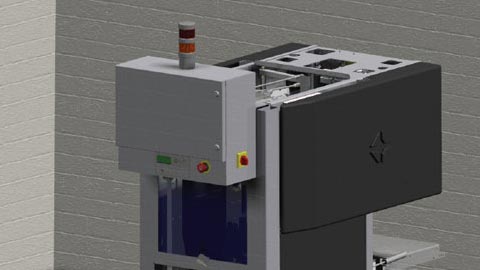Food processing equipment maker switches to Solid Edge to maintain reputation for leadership
Food processing equipment maker switches to Solid Edge to maintain reputation for leadership

Case Study
Diamond Systems upgrades to 3D to maintain its reputation for leadership
Diamond Systems
Implementing Solid Edge gives this food processing equipment manufacturer a visible advantage over the competition
To maintain its reputation as the technology leader, Diamond Systems wanted presentations to customers to look leading-edge.
Fast-moving machines that don’t break eggs
After using 2D AutoCAD for many years, designers and engineers at Diamond Systems switched to 3D CAD (Solid Edge® software from Siemens Digital Industries Software.) An important reason for the transition was to maintain the company’s leadership position among manufacturers of egg handling systems. “We’ve always been known as the technology leader in our industry, so one of the main things driving the upgrade was to make sure that presentations to our customers, in areas such as documentation and even sales meetings, were visibly leading-edge,” says Doug Flege, vice president of engineering at Diamond Systems. “With Solid Edge, we now have that. This, in my opinion, is as important as other advantages we have gained from 3D modeling, such as faster time-to-market and lower development costs.”
Diamond Systems, based in Farmington Hills, Michigan, is the world leader in egg packing, grading and breaking machines. The company develops, manufactures, markets and services its products to egg producers and egg processors on six continents. These complex machines have capacities from 22,000 to 72,000 eggs per hour. Grading systems load, wash, inspect, weigh and pack eggs into cartons and trays at rates of 14,000 to 144,000 eggs per hour. Breaker-separators load, wash, inspect, break and separate egg yolks from egg whites at speeds of 36,000 to 144,000 eggs per hour. Not only are these machines complex, they must operate flawlessly because of the extremely fragile nature of the product they handle.
Considering, implementing 3D
Every designer and engineer at Diamond Systems participated in the evaluation process for the new CAD software. They ruled out Autodesk Inventor early on. They briefly considered AutoCAD Mechanical Desktop but ruled it out as well because it looked too difficult to learn. The selection process came down to a thorough, side-by-side comparison of Solid Edge and SolidWorks. Solid Edge easily outperformed SolidWorks in sheet metal modeling, which was a critical need of the machine designers. Solid Edge also excelled in ease of use, which was another important requirement. “Most of our staff went from the drawing board to AutoCAD without training years ago, and their only experience has been in 2D,” explains Jason West, mechanical project engineer, Diamond Systems. “One thing that was really noticeable about Solid Edge was that, compared to SolidWorks, it is much easier to use. You need fewer commands and keystrokes to create parts and assemblies.” Drafting was another area in which Solid Edge excelled. “A test assembly took an entire day to produce in SolidWorks,” says West. “The same draft took two hours in Solid Edge.” Overall, the reviewers found Solid Edge to be more stable, and that it worked as promised. “Some of SolidWorks claims did not prove true. Everything Solid Edge promised, worked,” West adds.
Flege expected a certain amount of disruption as his staff learned the new software. To his pleasant surprise, the disruption was minimal. “Switching to 3D wasn’t a lot of trouble, and the big part of that is because we went with Solid Edge,” Flege says. “The main disruption was that we lost a week when we sent everyone to training. (Training was conducted by the reseller, CAM Logic.) But that actually paid off because by the end of that week most people were back to their previous level of productivity. And not long after, they surpassed that level.” Flege notes that the company’s chief engineer is 80 years old and the senior mechanical designer is in his 60s. Both made the transition to 3D easily. “They were up and running as fast as anyone else,” he says.
Flege expected a certain amount of disruption as his staff learned the new software. To his pleasant surprise, the disruption was minimal. “Switching to 3D wasn’t a lot of trouble, and the big part of that is because we went with Solid Edge,” Flege says. “The main disruption was that we lost a week when we sent everyone to training. (Training was conducted by the reseller, CAM Logic.) But that actually paid off because by the end of that week most people were back to their previous level of productivity. And not long after, they surpassed that level.” Flege notes that the company’s chief engineer is 80 years old and the senior mechanical designer is in his 60s. Both made the transition to 3D easily. “They were up and running as fast as anyone else,” he says.
One key to the smooth transition to 3D, Flege believes, is that people were aware and excited about it before it happened. “Rather than coming in saying, ‘You guys are all going to training next week to learn to draw in 3D,’ we got everyone involved from the start,” he explains. “Participating in the selection process got them excited about going to 3D. So when it came time for training, everyone was excited and ready to go.”
